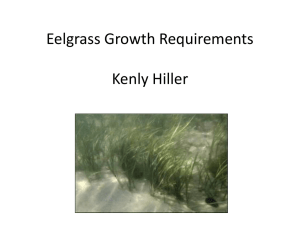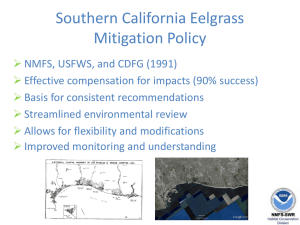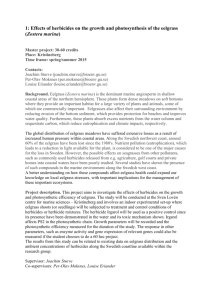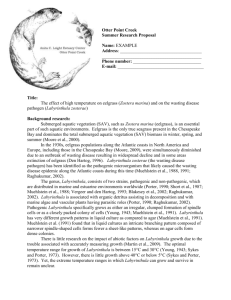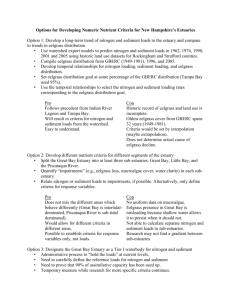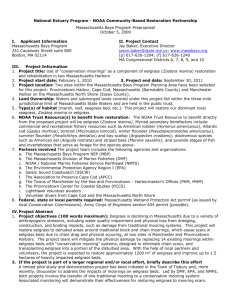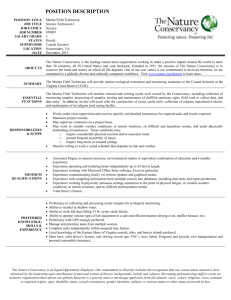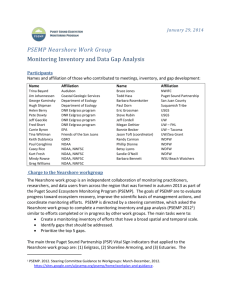HillerPaper2 - BIOEEOS660-f12
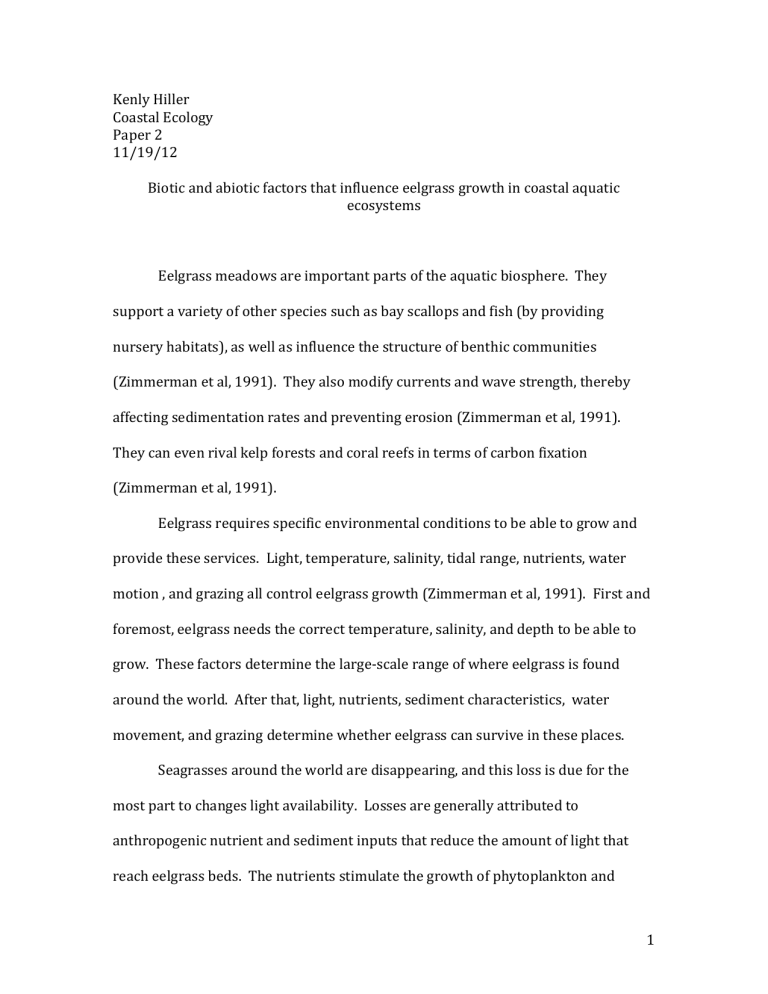
Kenly Hiller
Coastal Ecology
Paper 2
11/19/12
Biotic and abiotic factors that influence eelgrass growth in coastal aquatic ecosystems
Eelgrass meadows are important parts of the aquatic biosphere. They support a variety of other species such as bay scallops and fish (by providing nursery habitats), as well as influence the structure of benthic communities
(Zimmerman et al, 1991). They also modify currents and wave strength, thereby affecting sedimentation rates and preventing erosion (Zimmerman et al, 1991).
They can even rival kelp forests and coral reefs in terms of carbon fixation
(Zimmerman et al, 1991).
Eelgrass requires specific environmental conditions to be able to grow and provide these services. Light, temperature, salinity, tidal range, nutrients, water motion , and grazing all control eelgrass growth (Zimmerman et al, 1991). First and foremost, eelgrass needs the correct temperature, salinity, and depth to be able to grow. These factors determine the large-scale range of where eelgrass is found around the world. After that, light, nutrients, sediment characteristics, water movement, and grazing determine whether eelgrass can survive in these places.
Seagrasses around the world are disappearing, and this loss is due for the most part to changes light availability. Losses are generally attributed to anthropogenic nutrient and sediment inputs that reduce the amount of light that reach eelgrass beds. The nutrients stimulate the growth of phytoplankton and
1
epiphytes that contribute to shading, and the suspended particles scatter light and increase this shading problem (Moore et al, 1996). Furthermore, if oxygen concentrations or sediment redox potentials are too low, or water movement or grazing are too high, eelgrass will not grow in these locations either. It is therefore important to examine each environmental characteristic that determines eelgrass growth and distribution to determine ideal conditions for eelgrass establishment.
Through thorough examination of eelgrass biology, coastal ecosystems can be managed in a way that is conducive to restoring these vital members of aquatic ecosystems.
Temperature and Salinity
Temperature requirements differ among species and limit their broad scale geographical ranges. If it’s too cold, metabolic processes are restricted or eliminated, and if it’s too hot, respiration exceeds production (Greve and Binzer).
For example, the eelgrass commonly found around Neponset and on Cape Cod,
zostera marina, optimizes its photosynthesis to respiration rate at 5oC, but can grow in temperatures as warm as 35oC (Marsh et al, 1986). The most important thing to consider is the ways in which temperature alter the photosynthesis-irradiance (P-I) curve. The peak of this curve is the level of light at which the maximum rate of photosynthesis occurs. Within the limits of tolerance (on average 6-30oC for all eelgrass species), the rate of photosynthesis at light saturation doubles as temperature increases (Bulthuis, 1987). Therefore, we can expect climate change to shift global ranges of eelgrass species and alter their growth rates by increasing temperature stress (Short and Neckles, 1999).
2
On average across species, seagrasses grow from 5-45ppt (Greve and
Binzer). Many seagrasses are well adapted to changes in salinity due to fluctuations in estuarine environments. For example, zostera marina can survive swings from
5ppt to 30ppt in a single tidal cycle. According to Kamermans et al. (1999), zostera
marina grows best at 22psu as opposed to 32 psu. Moore et al (1996) found a 10% decrease in biomass of zostera marina due to salinity drops in upriver sampling locations where salinity was 10psu. These factors determine where eelgrass can grow in a broad geographic sense, but they do not grow everywhere where temperature and salinity are ideal. Factors such as light, nutrient concentrations, sediment type, and water movement determine whether eelgrass can persist in a specific location.
Nutrients and Light
Eelgrass communities are very sensitive to light levels. Light most often controls the depth, distribution, and productivity of eelgrass (Zimmerman et al,
1991). Light determines how deep eelgrass can grow because light needs to penetrate the water column to reach down to the submersed eelgrass below (Greve and Binzer). It makes sense that turbidity can have detrimental effects on eelgrass biomass. Losses of eelgrass are therefore usually attributed to things that cause turbidity (Moore et al, 1996). Nutrients cause phytoplankton blooms and increase epiphyte growth, both of which can increase shading. Suspended solids can also block the light directly.
Nutrients and light are closely intertwined in terms of eelgrass growth, because nutrients often stimulate the growth of organisms that shade out eelgrass.
3
Epiphyte blooms, for example, allow decreased light to reach eelgrass and inhibit molecular transport across plant epidermal surfaces by covering them up (Twilley et al, 1985). Twilley et al (1985) found that the total amount of epiphytes increased with nutrient concentration (Fig. 1). These epiphytes were found to attenuate photosyntheticlly active radiation (PAR) with a strong correlation (Twilley et al,
1985, Cambridge et al, 1986, Fig. 2). This is bad because net production generally increases with PAR (Fig. 3). Light compensation levels for one species of eelgrass
(potamogeton perfoliatus) were found to be 50-100uE/m2. At high nutrient concentrations, with epiphytic colonization reaching 4g dry weight per gram dry weight of eelgrass, only about 40uE/m2 would reach eelgrass at a depth of only
0.5m. Furthermore, Montfrans et al (1984) found that similarly high densities of epiphytes can reduce photosynthesis by 58%. In this study, eelgrass biomass between beds with and without epiphytes differed by up to 18g dry weight per square meter. This clearly shows the detrimental effects that epiphytes can have once they become prevalent in the system. if nutrient concentrations are high, epiphyte biomass may be high, and light will not be available for eelgrass growth.
Epiphytes cover the skin of eelgrass and can therefore block its ability to absorb carbon and nutrients. An interesting indirect effect was found by Montfrans et al
(1984). They found that mats of macroalgae and associated microalgae attached to seagrasses can cause the pH to increase to 9.4 during the day. Under these conditions, the seagrasses cannot take up enough bicarbonate to perform photosynthesis.
4
Epiphytes do not always have a detrimental affect. In the Chesapeake Bay, invertebrate grazing or temperature may limit epiphyte growth (Moore et al, 1996).
This allows light to penetrate deeper into the water column even at higher nutrient loading rates. Furthermore, in Waquoit Bay in Falmouth, MA, epiphyte removal had no effect on growth rates, indicating these plants were nutrient limited rather than light limited (Bohrer et al, 1995). Therefore, other factors in a system, such as grazing or nutrient concentrations, can alter the importance of epiphytes.
Phytoplankton blooms can also contribute to shading, thereby reducing the amount of light available to eelgrass for photosynthesis. For example, in a study during which experimental marine ponds were fertilized with different nutrient concentrations, the highly fertilized ponds had the most elevated concentrations of planktonic chlorophyll (Twilley et al, 1985). This all depended on the concentration in question, though. Light attenuation was not significantly different between low
(30uM) and medium (60uM) inorganic nitrogen concentrations. Low concentrations actually stimulated the growth of eelgrass, probably because it was relieving nutrient limitation on the eelgrass population (Twilley et al, 1985).
Bohrer et al (1995) found similar results. Eelgrass was only gone in places with high nitrogen loading rates (39-45gN/m2/year). However, Gallegos and Kenworthy
(1996) found that persistent seagrass growth was only possible in areas where chlorophyll a was less than 15mg/m3 during the growing season. It varies based on the relative importance of epiphytes, phytoplankton, and suspended solids in shading. In addition to contributing to shading, phytoplankton blooms in summer
5
can cause nutrient limitation of seagrass growth because the blooms take up such a substantial amount of available N (Pederson and Borum, 1993).
The effects of phytoplankton blooms on shading are highly variable. A lot of factors can influence phytoplankton blooms, such as pH and grazing, so blooms fluctuate a lot. In the shallow experimental ponds used by Twilley et al. (1985), phytoplankton only bloomed at high nutrient concentrations (120uM inorganic nitrogen), while epiphytes did at all concentrations. This indicates that epiphytes could be a more prevalent problem. If this is the case, phytoplankton growth and shading can be subsequent, rather than the cause of eelgrass decline (Phillips et al,
1978).
Living organisms are not the only things that can shade out eelgrass. Shading due to suspended solids is can also limit their depth distribution. For example, transplant losses of eelgrass were most severe in deep, upriver portions of a
Chesapeake tributary due to high total suspended solids (TSS) concentrations
(Moore et al, 1996, Fig. 4). The trouble occurred when TSS concentrations were from 15-40mg/l, so concentrations should be kept below this in order to reduce shading. TSS loads reduced production so much that they were unable to store carbohydrates during the spring growing season. Without these carbohydrates, the eelgrass cannot weather poor growing conditions in the winter or high respiration rates in the summer, so they die off (Moore et al, 1996). Gallegos and Kenworthy
(1996) found that in Chesapeake Bay, sites with persistent submerged aquatic vegetation (SAV) beds to depths of one meter or greater occurred only where
6
median concentrations of TSS were less than 15g/m3 (15mg/l), which agrees with
Moore et al (1996).
In another study, Kemp et al (1983) found that TSS is a far greater component to total turbidity (and therefore total light attenuation) over algae. TSS concentrations increasing from 20-100 mg/l during summer winds would result in a 50% decline in PAR at a depth of only 50cm (Kemp et al, 1983). In this study, PAR correlated with TSS, not chlorophyll, indicating phytoplankton blooms had little effect on shading. Light requirements for eelgrass are, on average, 75-150uE/m2/d. if you have light attenuation coefficients (k) above 2/m, seagrasses are exposed to light levels close to their compensation point when production equals respiration
(Kemp et al, 1983). They cannot grow under these conditions. Below this compensation point at 75uE/m2/d, not even adaptations like more chlorophyll per leaf area or stem elongation to reach up to the light can help. In this case, Secchi depths dropped from 0.8 to 0.35m, which equals an increase in k (light attenuation) from 1.8 to 4/m, which caused a significant drop in the depth distribution of eelgrass from 1.4 to 0.6m. from this, they concluded that a median light attenuation of 1.5/m is necessary for eelgrass persistence at one meter, and that in order to recover eelgrass to a depth of two meters, you need a coefficient of 0.8/m. These factors should all be monitored to determine whether a system is suitable for persistent eelgrass growth.
Despite the negative indirect effects of nutrients, they are also essential for eelgrass growth. Eelgrasses absorb nutrients from the water column through their leaves and from sediment pore waters through their roots (Bulthuis et al, 1992).
7
The most important nutrient for eelgrass growth is nitrogen, since this is often the limiting nutrient in coastal ecosystems. Nitrogen requirements vary over the year as growth rates change. They can reach as high as 0.13mgN/shoot/day in the summer and as low as 0.03mgN/shoot/day in winter in the Mediterranean
(Alcoverro et al, 1997). Pederson found similar numbers (Pederson et al, 1983, Fig.
5). Nutrient requirements for eelgrass are four times lower per weight than those for phytoplankton, meaning they win in nutrient-limited environments (Greve and
Binzer). As long as nutrient loading is relatively low (concentrations around 30uM), then eelgrass may benefit. Nutrient concentrations are therefore also vital to monitor to predict whether eelgrass can survive in a particular environment.
Oxygen
Oxygen is also important for eelgrass growth. They usually grow in anoxic sediments, so they must transport oxygen from the water column by diffusion from leaves (Greve andBinzer). Sometimes, systems become stratified due to nutrient loading because phytoplankton blooms die and get degraded, and microbes consume all oxygen in the water during this process. If this occurs, oxygen diffusion shuts down and eelgrass can die due to oxygen starvationin the roots (Greve and
Binzer). Furthermore, in anoxic sediments with brackish porewater, sulfate reduction can occur. High sulfide concentrations as a result of sulfate reduction can inhibit eelgrass growth because it’s a plant toxin that inhibits respiration (Greve and
Binzer). These effects are species-specific, and it appears that only very high concentrations (over 100uM) actually harm the seagrass (Terrados et al, 1999).
Eelgrass cannot oxidze the sulfide to sulfate before it enters the plant without access
8
to oxygen. High sediment iron content can prevent this, though, because it can precipitate out with sulfide. Oxygen must also be measured to ensure that anoxia will not inhibit eelgrass growth.
Sediment type (substrate)
Light and nutrients definitely dominate the literature on eelgrass growth, but there are many factors in an ecosystem that can affect eelgrass survival. These are sediment type, water movement and chemistry, and grazing. Seagrasses generally grow on soft substrata such as mud or sand (Terrados et al, 1999). Sediments with increased silt or clay fractions show lower seagrass biomasses (Livingston et al,
1998). Sediment Eh values in seagrass beds are usually between -100 and 200mV in the top ten cm (Terrados et al, 1999). Eelgrass bed sediments are therefore ideally only moderately reduced. Increasing organic matter from phytoplankton die-offs or anthropogenic inputs can increase sulfide concentrations and decrease Eh, which reduces the number of eelgrass shoots (Terrados et al, 1999). Eelgrass production therefore decreases over time in more highly reducing sediments. For zostera
marina, which is most common around Neponset, the detrimental effects of dropping Eh were not crippling. Shoot density was unaffected and growth was restricted by less than a centimeter per day (Terrados et al, 1999).
Water movement
Changes in water flow or velocity can alter the biomass and species composition of SAVs (Madsen et al, 2001). Rough water movement can have direct negative effects like stretching and breaking as well as indirect effects such as
9
alterations in gas exchange (Madsen et al, 2001). If oxygen is whisked away from the plant before it can be taken up, then it will not be able to survive. Eelgrass biomass is positively correlated with flow velocities from 0-0.10m/s because these flow rates prevent stagnation and allow fresh metabolites to flow around the eelgrass beds (Cambridge et al, 1986). Anything above that becomes damaging.
Furthermore, excessive water movement may alter the sedimentation regime by bringing more suspended sediment into the area. Rapid sediment accretion may reduce the area of seagrass meadows (Cambridge et al, 1986). Also, wave action determines the shallowness of depths that eelgrass can colonize. According to
Greve and Binzer, they can’t exist if flow velocities due to wave action are higher than 1.5m/s or they’ll be uprooted. Increased storm intensity due to climate change would theoretically have damaging effects on eelgrass for the same reason.
Grazing
Grazing can be detrimental to eelgrass populations by sheer removal of biomass. The burrowing activities of crustaceans or fish during the growing season can wreak havoc on a seagrass bed. Orth (1975) found that entire beds of zostera
marina can be uprooted and consumed by the cownose ray. In the study done by
Cambridge et al (1986) in Cockburn Sound, Australia, grazing by sea urchins significantly lowered biomass. Grazing pressures on top of environmental stress may result in weak eelgrass that is unable to fight off the wasting disease caused by the labrythula slime mold (Moore et al, 1996). This could be the final nail in the metaphorical coffin for eelgrass.
10
Implications for Neponset
Based on this review, the causes of local eelgrass decline in different locations vary widely. In some cases, high TSS concentrations cause shading that limit eelgrass depth. In others, epiphytes are to blame. In yet other cases, indirect effects like alterations in sediment chemistry or anoxia due to increased nutrient loads are to blame. However, these results do tell us what we should be monitoring in order to get an idea of how well eelgrass would grow in Neponset. Most of them are already being done for the Neponset river. We know salinity, TSS, light attenuation coefficients (k), Secchi depths, chlorophyll a, and nutrient concentrations. TSS actually looks lower than the critical number of 15mg/l in the
Neponset River (Fig. 6). Also, if we look at pooled nitrate concentrations across all years toward the mouth of the river (closest to the estuary), nutrient levels look promising. They’re lower than the “low” nutrient treatment used by Twilley et al
(1985) (Fig. 7). The attenuation coefficient for the river reaches all the way up to
3.5/m, so TSS and algal blooms may be combining to increase turbidity.
The problem is that we don’t have any of these data for the estuary. The river is probably too fresh to support eelgrass growth. We need to know TSS concentrations, chlorophyll a, and epiphyte growth densities to determine the level of shading that’s occurring. Attenuation coefficients and Secchi depths will also be critical to determining whether there is enough light for eelgrass to grow. Sediment type and redox potential would also be important to determine. We do know river flow rates, so measuring some of these in the estuary would be good to determine if
11
water is flowing to quickly to support eelgrass. Finally, measuring grazer biomass may also help indicate whether eelgrass transplants will survive.
12
Fig. 1: A figure from Twilley et al (1985) showing how epiphyte biomass increases with nutrient concentration.
13
Fig. 2: Figure from Twilley et al (1985) showing how epiphytes decrease the amount of light reaching eelgrass beds.
Fig. 3: Figure from Twilley et al (1985) showing how net production increases with
PAR up to a certain point. Reducing PAR will therefore reduce net production.
14
Fig. 4: TSS and k found in an unhealthy Chesapeake system from a figure in Moore et al (1996).
15
Fig. 5: Nutrient uptake from Pederson et al (1983).
16
Fig. 6: Secchi depth vs. TSS across all available years in the Neponset River.
17
River Mouth
0 10 30 50
Nitrate+Nitrite (uM)
70 0 10 30 50
Nitrate+Nitrite (uM)
Fig. 7: Nitrate concentrations look relatively low at the mouth of the river.
70
18
Literature Cited:
Alcoverro, T. et al. 1997. Spatial and temporal variations in nutrient limitation of seagrass Posidonia oceanica growth in the NW Mediterranean. Mar. Ecol. Prog. Ser.
146: 155-161.
Bohrer, T. et al. 1995. Effect of epiphyte biomass on growth rate of zostera marina in estuaries subject to different nutrient loading. Biol. Bull . 189: 260.
Bulthuis, D. 1987. Effects of temperature on photosynthesis and growth of seagrasses.
Aquatic Botany 27: 27-40.
Bulthuis, D. et al. 1992. Growth of the seagrass heterozostera tasmanica limited by nitrogen in Port Phillip Bay, Australia. Mar. Ecol. Prog. Ser. 89: 269-275.
Cambridge, M.L. et al. 1986. The loss of seagrass in Cockburn Sound, western Austrailia.
II. Possible causes of seagrass decline. Aquatic Botany 24: 269-285.
Carroll, J. et al. 2008. Resource-restricted growth of eelgrass in New York estuaries: light limitation, and alleviation of nutrient stress by hard clams. Mar. Ecol. Prog. Ser. 369: 51-
62.
Gallegos, C.L. and W.J. Kenworthy, 1996. Seagrass depth limits in the Indian River
Lagoon (Florida, USA): Application of an optical water quality model. Estuarine,
Coastal, and Shelf Science 42: 267-288.
Greve, T.M. and T. Binzer. Which factors regulate seagrass growth and distribution? www.vliz.be/imisdocs/publications/67181.pdf
Kamermans, P. et al. 1999. Significance of salinity and silicon levels for growth of a formerly estuarine eelgrass (Zostera marina) population (Lake Grevelingen, The
Netherlands). Marine Biology 133: 527-539.
Kemp, W.M. et al. 1983. The decline of submerged vascular plants in upper Chesapeake
Bay: summary of results concerning possible causes.
MTS Journal: 17: 78-89.
Livingston, R.J. et al. 1998. Factors controlling seagrass growth in a gulf coastal system:
Water and sediment quality and light. Aquatic Botany 60: 135-159.
Madsen, J.D. et al. 2001. The interaction between water movement, sediment dynamics and submersed macrophytes. Hydrobiologia 444: 71-84.
Marsh, J.A. et al, 1986. Effects of temperature on photosynthesis and respiration in eelgrass ( zoztera marina L.). Journal of Experimental Marine Biology and Ecology 101:
257-267.
19
Montfrans, J. et al. 1984. Epiphyte-grazer relationships in seagrass meadows: consequences for seagrass growth and production. Estuaries 7: 289-309.
Moore, K.A. et al. 1996. Zostera marina (eelgrass)growth and survival along a gradient of nutrients and turbidity in the lower Chesapeake Bay. Mar. Ecol. Prog. Ser.
142: 247-259.
Pederson, M.F. and J. Borum, 1993. An annual nitrogen budget for a seagrass zostera marina population. Mar. Ecol. Prog. Ser. 101: 169-177.
Phillips, G.L. et al. 1978. A mechanism to account for macrophyte decline in progressively eutrophicated freshwaters. Aquatic Botany 4: 103-126.
Short, F.T. and H.A. Neckles, 1999. The effects of global climate change on seagrasses.
Aquatic Botany 63: 169-196.
Terrados, J. et al. 1999. Are seagrass growth and survival constrained by the reducing conditions of the sediment? Aquatic Botany 65: 175-197.
Twilley, R.R. et al. 1985. Nutrient enrichment of estuarine submersed vascular plant communities. 1. Algal growth and effects on production of pants and associated communities. Mar. Ecol. Prog. Ser. 23: 179-191.
Zimmerman, R.C. et al. 1991. Assessment of environmental suitability for growth of zostera marina L. (eelgrass) in San Francisco Bay. Aquatic Botany 39: 353-366.
20
